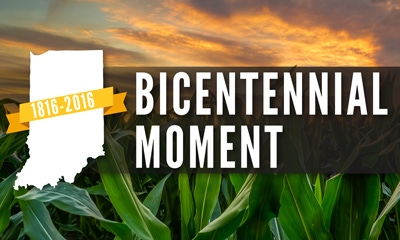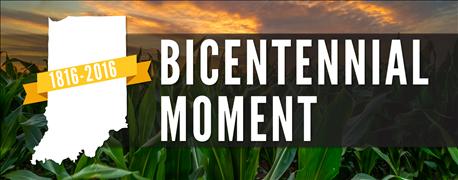
John Dunning is not a stranger to hard work, nor to changes in technology. He still comes to the Indiana State Fair every year, and often operates the silage demonstration in Pioneer Village. Like most other Pioneer Village volunteers who don overalls and spend 17 days demonstrating techniques of days gone by, Dunning feels it’s important to preserve the old ways so younger generations can learn what farming was like in the past.
Here are three steps Dunning goes through when he feeds the ensilage cutter and runs a silage demonstration for the public to watch at Pioneer Village. Dunning, Spencer, farms in the White River bottoms, and raises corn and soybeans today.

Step 1. Tighten the belt on the tractor to drive the ensilage cutter.
Anyone who has ever powered a machine by a long belt knows the importance of getting the belt tight. A modern stand marker (note the concrete marker in photo below) was used here to chock the wheels. In the old days it was often a rock or maybe a chunk of wood.
Once the belt was tight, you didn’t dare let the tractor slip forward so the belt could loosen up again.

FILL THE SILO: Running farm machinery off belts may seem like it was 200 years ago, but it came well after the horse. John Dunning tightens the belt in preparation to run the ensilage cutter.
Step 2. Cut and make bundles of corn, and bring them into the silo.
Dunning still operates a corn binder to prepare bundles to bring to the state fair. “The corn was greener than I like this year because we couldn’t plant until late May,” he reports.
“My corn was pretty thick this year, and the old binder really wasn’t designed to work in corn that thick,” he adds. “It was spitting out those bundles pretty fast.”
Once the bundles are up at the silo, which in this case is actually picket fence to contain the silage chopped during the fair, Dunning feeds the stalks whole into the ensilage cutter, which chops and blows the silage up and into the mock silo.

FEED IN CORN: Before the days of silage choppers, corn was cut and came to the silo whole. An ensilage cutter and blower then chopped corn and blew it into the silo.
Step 3. Blow silage into the silo and check the condition of the corn.
Dunning knew from experience that his corn was still pretty green to chop. The old Papec ensilage cutter and blower handled it well, chopping it into fine pieces, which immediately produced that distinctive odor of fresh, green-chopped corn.
The sign placed on the picket fence warned people not to feed any of the silage to pets or livestock. High nitrates in the green corn might be an issue. That bit of knowledge was discovered long after the old Papec unit was built.

MODERN SCIENCE STEPS IN: Notice the sign on the picket fence holding the silage cut at Pioneer Village. It warns of using this very green corn ensilage because of high nitrate levels.
About the Author(s)
You May Also Like




